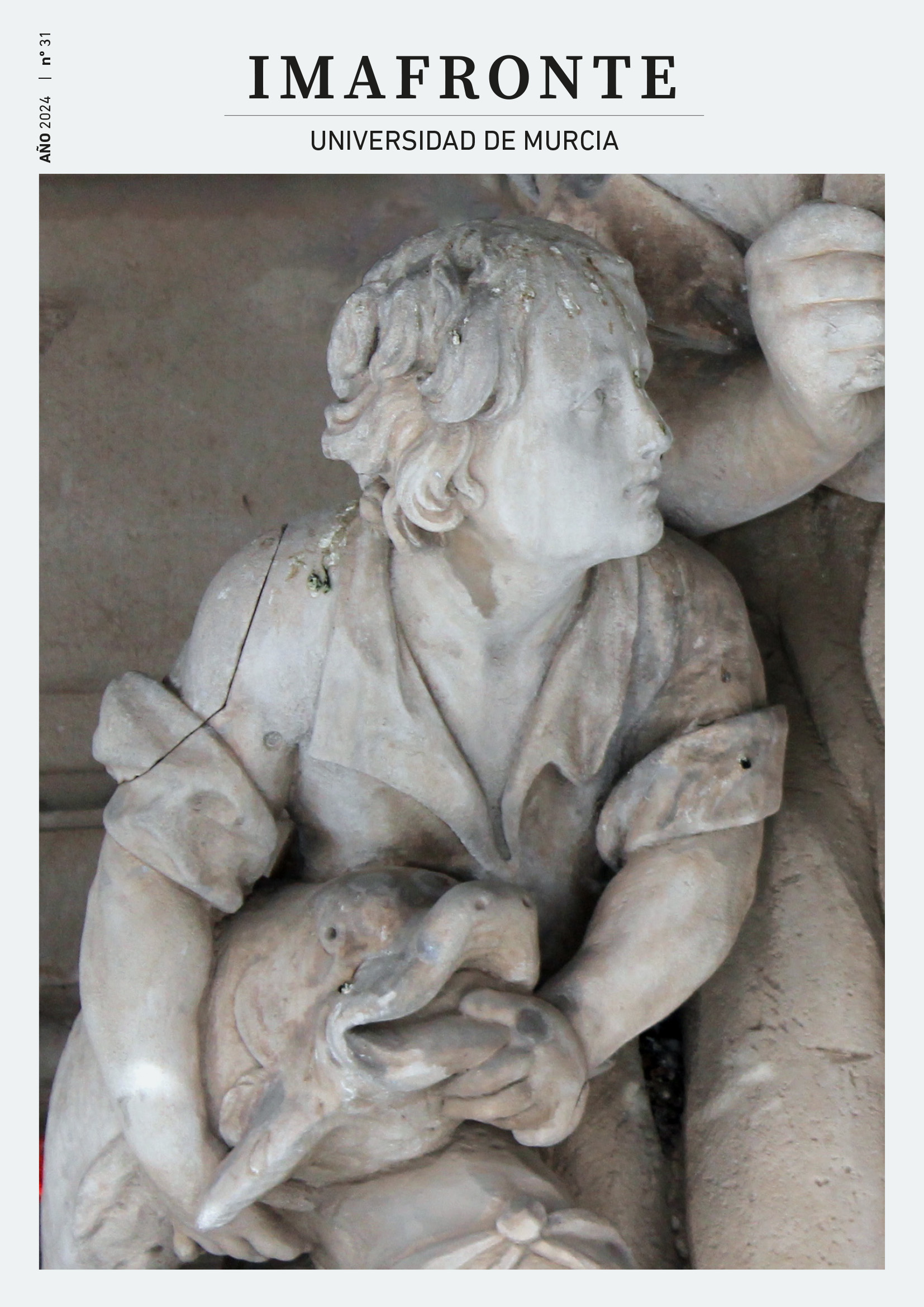Devotion and Erotism in Sixteenth and Seventeenth Century Italy. Portraying the Penitent Magdalene
Abstract
The aim of this paper is to analyze the image of the penitent Magdalene in 16th and 17th century Italy, focusing on issues of corporality, sexuality, eroticism and devotion. A diachronic analysis shows the transformations of the penitent saint from her asexual body in the medieval centuries to the sensuality that her figure emanates in Italian Renaissance and Baroque painting. Special attention is paid to the tensions between devotion and eroticism that some of these images generate. Thus, among the objectives is the study of the relationships between form and meaning derived from the analysis of compositional schemes, the uses that these images had at the time, their connection with Neoplatonic philosophy and the ideals of beauty. Likewise, there is a brief discussion about the terms "pornography" and "eroticism" in the context of these centuries. All this is carried out under the prism of the tradition of iconology studies, including the gender perspective in the analysis of the works.
Downloads
-
Abstract664
-
PDF (Español (España))441
-
EPUB (Español (España))156
References
Alexandrakis, A. y Moutafakis, N. (eds.) (2002). Neoplatonism and Western Aesthetics. Nueva York: State University of New York Press.
Antunes, J. (2014). The Late-Medieval Mary Magdalene: Sacredness, Otherness, and Wildness. En Peter Loewen y Robin Waugh (eds.). Mary Magdalene in Medieval Culture: Conflicted Roles. Nueva York: Routledge, 116-139.
Baschet, A. y Fuillet de Conches, F. (1865). Les femmes blondes selon les peintres de l’école de Venise. París: A. Aubri editor.
Begel, A. (2012). Exorcism in the Iconography of Mary Magdalene. En Michelle Erhardt y Amy Morris (eds.). Mary Magdalene. Iconographic Studies from the Middle Ages to the Baroque. Boston: Brill, 341-360.
Bernabé, C. (1994). María Magdalena. Tradiciones en el cristianismo primitivo. Estella: Verbo Divino.
Bornay, E. (2010). La cabellera femenina. Madrid: Cátedra.
Bornay, E. (1998). Mujeres de la Biblia en la pintura del Barroco. Madrid: Cátedra.
Clarke, John R. (2013). Before Pornography: Sexual Representations in Ancient Roman Visual Culture. En Hans Maes (ed.). Pornographic Art and the Aesthetics of Pornography. Basingstoke: Palgrave, 141-161.
De Boer, E. A. (1997). Mary Magdalene. Beyond the Myth. London: SCM Press Ltd.
Fedele, A. (2012). Looking for Mary Magdalene. Alternative Pilgrimage and Ritual Creativity at Catholic Shrines in France. Oxford and New York: Oxford University Press.
Firenzuola, A. (1552). Dialogo delle bellezze delle donne. Venecia: Giouan Griffio.
Haskins, S. (1996). María Magdalena. Mito y metáfora. Barcelona: Herder.
Hofstadter, A. y Kuhns, R. (2009). Philosophies of Art and Beauty: Selected Readings in Aesthetics From Plato to Heidegger. Chicago: University of Chicago Press.
Hornik, H. J. (2014). The Invention and Development of the ‘Secular’ Mary Magdalene in Late Renaissance Florentine Painting. En Peter Loewen y Robin Waugh (eds.). Mary Magdalene in Medieval Culture. Conflicted Roles. Nueva York: Routledge, 75-98.
Iterián de Ayala, Juan (1782). El pintor christiano y erudito, ó Tratado de los errores que suelen cometerse freqüentemente en pintar, y esculpir las Imágenes Sagradas. Madrid: Joaquin Ibarra. Disponible en http://www.cervantesvirtual.com/obra/el-pintor-christiano-y-erudito-o-tratado-de-los-errores-que-suelen-cometerse-frequentemente-en-pintar-y-esculpir-las-imagenes-sagradas--0/
Jansen, K. L. (2001). The Making of the Magdalen: Preaching and Popular Devotion in the Later Middle Ages. Princeton: Princeton University Press.
López de Ayala, I. (trad.) (1853). De Invocatione, veneratione et reliquiis Sanctorum, et sacricis imaginibus. El sacrosanto y ecuménico Concilio de Trento. París: Librería de Rosa.
Maisch, I. (1998). Between Contempt and Veneration… Mary Magdalene. The Image of a Woman through the Centuries. Collegeville, Minnesota: The Liturgical Press.
Marino, G. B. (1913). XIV. Maddalena. En Poesie varie. Edición a cargo de Benedetto Croce, Bari: Laterza. Disponible en https://archive.org/details/2poesievariecura00mariuoft/mode/2up
Montaigne, M. (1580). Apología de Raimundo Sabunde. En Ensayos, Libro II, cap. II. s.l.
Autor. (2017).
Moseley-Christian, M. (2012). Marketing Mary Magdalene in Early Modern Northern European Prints and Paintings. En Michelle Erhardt y Amy Morris (eds.). Mary Magdalene. Iconographic Studies from the Middle Ages to the Baroque. Boston: Brill, 399-419.
Moulton, I. F. (2013). Erotic Representations 1500-1750. En Sarah Toulalan and Kate Fisher (eds.). The Routledge History of Sex and the Body: 1500 to the Present. Londres – Nueva York: Routledge, 207-222.
Panofsky, E. (1972). Estudios sobre iconología, Madrid: Alianza.
Pollock, Griselda (2007). La heroína y creación de un canon feminista. Las representaciones de Artemisia Gentileschi de Susana y Judit. En Karen Cordero y Inda Sáenz (eds.). Crítica feminista en la teoría e historia del arte. Mexico D.F: Universidad Iberoamericana, 161-196.
Ricci, C. (1994). Mary Magdalene and Many Others. Women who Followed Jesus. Minneapolis: Fortress Press.
Salomon, N. (1996). The Venus Pudica: uncovering art history’s ‘hidden agendas’ and pernicious pedigrees. En Griselda Pollock (ed.). Generations and Geographies in the Visual Arts: Feminist Readings. Londres – Nueva York: Routledge, 69-87.
Sautel, R. P. (1684). Divae Magdalenae ignes sacri et piae lacrimal. Colonia: s.e.
Schaberg, J. (2008). La resurrección de María Magdalena. Leyendas, apócrifos y Testamento cristiano. Estella: Verbo Divino.
Tinagli, P. (1997). Women in Italian Renaissance Art: Gender, Representation and Identity. Manchester: Manchester University Press.
Vasari, G. (1994). Vita di Tiziano. Pordedone: Edizioni Studio Tesi.
Villena, L. A. (trad., prólogo y notas) (2007). Pietro Aretino. Sonetos Lujuriosos. Madrid: Visor Libros.
Zuccaro, F. (1768). L’idea de’ pittori, scultori ed architetti del cavalier Federigo Zuccaro divisa in due libri. Roma: Marco Pagliarini.
Copyright (c) 2024 Elena Monzón Pertejo

This work is licensed under a Creative Commons Attribution-ShareAlike 4.0 International License.
1. The authors non-exclusively assign the exploitation rights (reproduction, distribution, communication and transformation) to the magazine.
2. The works published in this magazine are subject to the Attribution-ShareAlike 4.0 International license (CC By SA 4.0). Therefore, they can be copied, used, disseminated, transmitted and publicly displayed, provided that:
i) the authorship and the original source of its publication (journal, editorial and URL of the work) are cited, thus allowing its recognition.
ii) it is allowed to remix, transform or create from the material while maintaining the same license as the original.

3. Self-archiving conditions. Authors are allowed and encouraged to electronically disseminate the pre-print (version before being evaluated) and/or post-print (version evaluated and accepted for publication) versions of their works before publication, as it favors their publication. Earlier circulation and diffusion and with it a possible increase in its citation and reach among the academic community. Color RoMEO: verde.






















